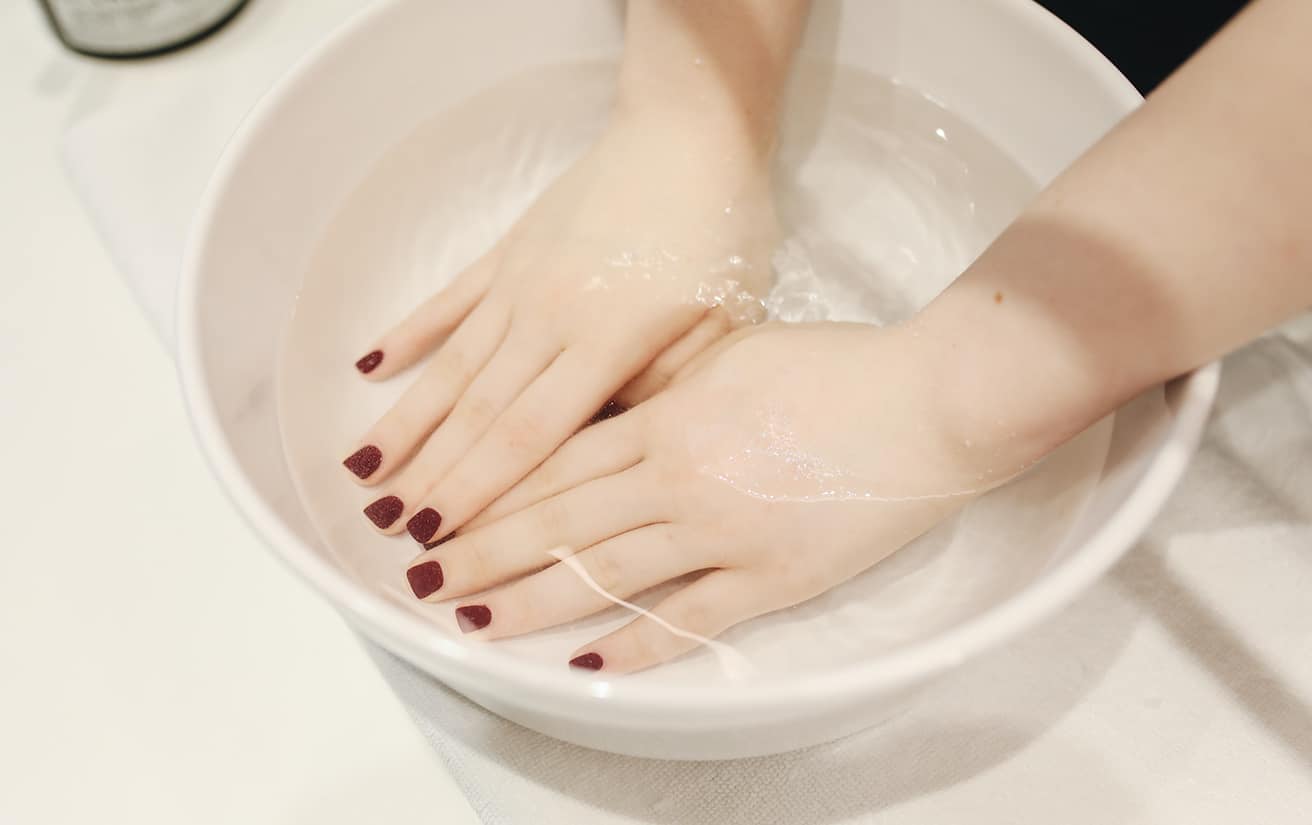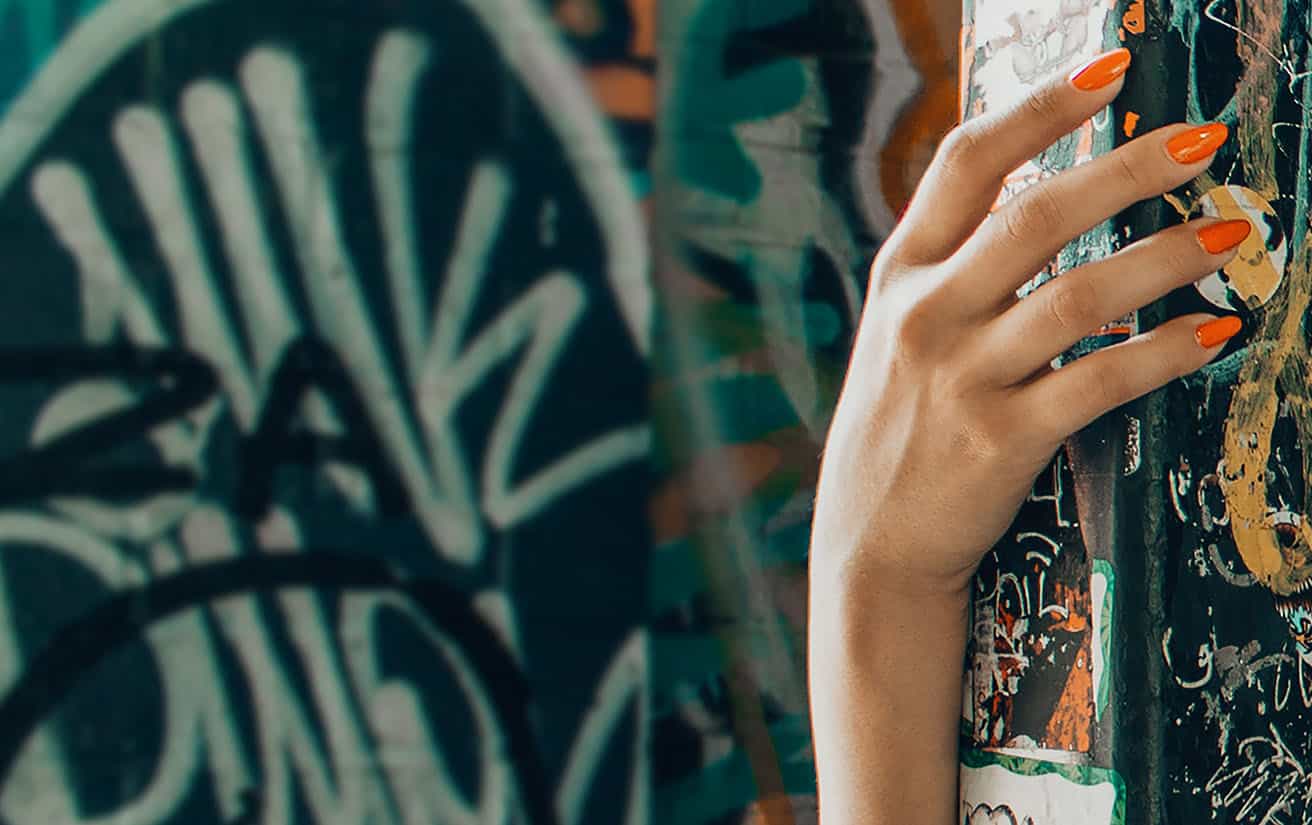What Are SolarNails?
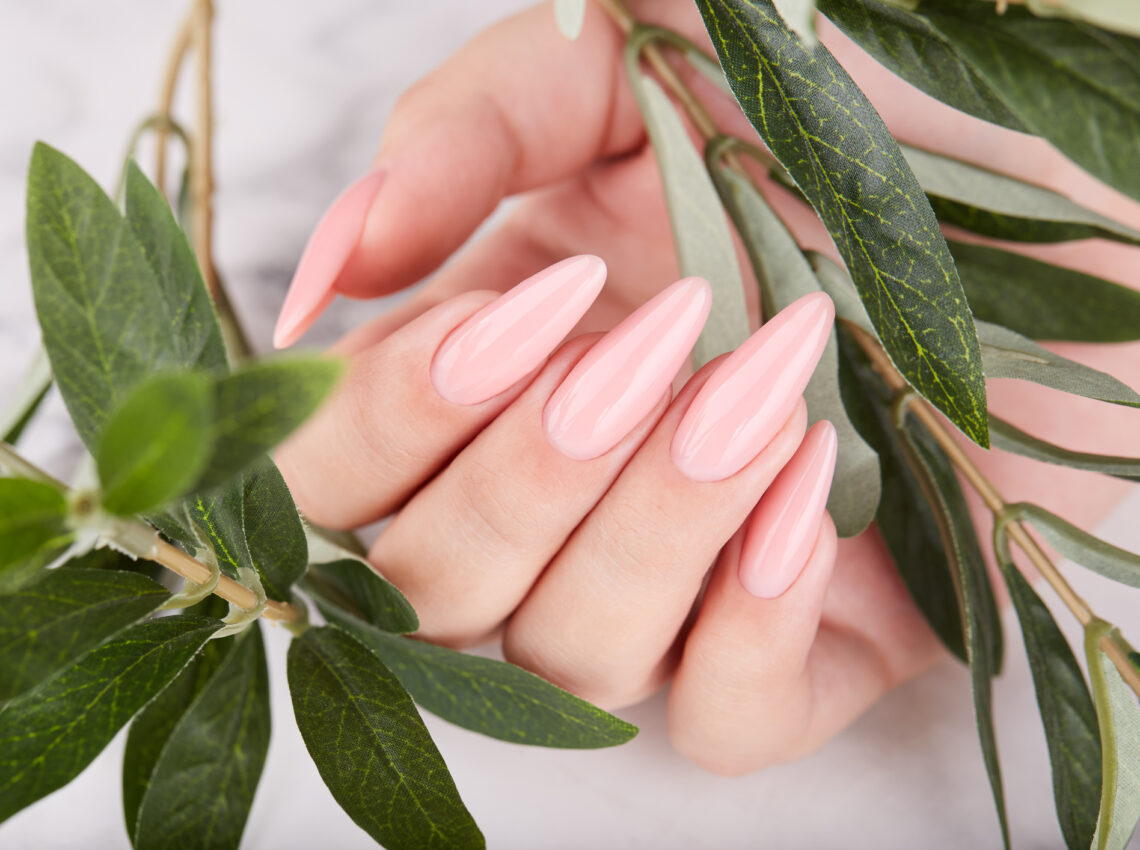
Ready to switch things up at the nail salon? With so many types of manicures and pedicures trending, choosing a style from all the different options available can be overwhelming. If you’ve been looking for high-quality artificial nails, you may have heard of SolarNails and wonder what they’re all about. This article describes the features of this brand-name of acrylic nail, as well as how SolarNails differs from other types of nails.
Table of Contents

What are SolarNails?
SolarNails are simply a specific brand of acrylic nails from Creative Nail Design (CND). This type of acrylic often has the look of a French manicure — pink nail topped by a white tip — so your salon may call SolarNails “pink and whites.” However, like all acrylic nails, SolarNails can take on any shade of color, shape, and have nail art applied to them. You may see SolarNails listed as “solar nails” at the salon, but SolarNail is actually a trademarked product of CND.
How much do SolarNails cost?
Although prices differ based on the location and level of luxury of the nail salon and the expertise of the nail technician, expect the base price for a full set of acrylic nails to vary widely, from $25 to $120. Then add $10 to $15 for a premium set of artificial nails like SolarNails, because salons pay a little extra for brand-name supplies.
How long do SolarNails last?
Since SolarNails are acrylic nails, they last for six to eight weeks. To close the gaps created at your nail bed when nails grow, this manicure needs to be filled every two or three weeks.
Advantages and disadvantages of SolarNails
Since CND’s SolarNails are a type of acrylic nail, you may wonder what benefits a name-brand like this can offer. The following sections explain the advantages and disadvantages of SolarNails so you can make an informed decision the next time you visit the nail salon.
Advantages
- Extreme durability: Stronger than your natural nail, SolarNails resist chipping and protect the natural nail underneath it.
- Accepts a wide variety of nail art: The smooth surface of SolarNails makes them a ready candidate for all types of nail art enhancements.
- No need for UV light treatment: Although SolarNails take a bit longer than other nail extensions to harden by air, they harden without curing under a UV light.
- Ability to quickly lengthen nails: SolarNails are attached to your nails and cut to any custom length you want.
- Easy removal process: SolarNails don’t require a lot of work to remove. In fact, you can do the simple soak and remove them yourself at home.
- Does not cause your nails to yellow: CDN states that SolarNail liquid was “the industry’s first-ever monomer formulation for greater nail strength and flexibility — and the first product to deliver natural, non-yellowing nail color.”
Disadvantages
- A less natural appearance: Since nail technicians apply SolarNails to the top of your existing nails, they look less natural and more pronounced than your real nails, although a talented technician can make them look pretty close.
- Damage to your nails: Acrylic nails can damage your existing nails, make it difficult for your real nails to grow out, and offer fertile ground for fungus and bacteria.
- Extra cost: SolarNails last up to two months, you need to spend money on fills and pay a premium upfront for the name brand.
Types of acrylic nails
For many years, the main ingredient in acrylic nails was methyl methacrylate monomer (MMA). Following years of consumer complaints about skin and nail damage, the majority of states banned its use in manicure and pedicure products. While the FDA allows the chemical in nail polish and other nail products, it strongly urges consumers to avoid MMA.
SolarNails is a type of acrylic made with ethyl methacrylate (EMA). While the FDA considers this polymer safe, careful nail technicians still make sure it doesn’t touch the skin because it can cause allergic reactions for some people.
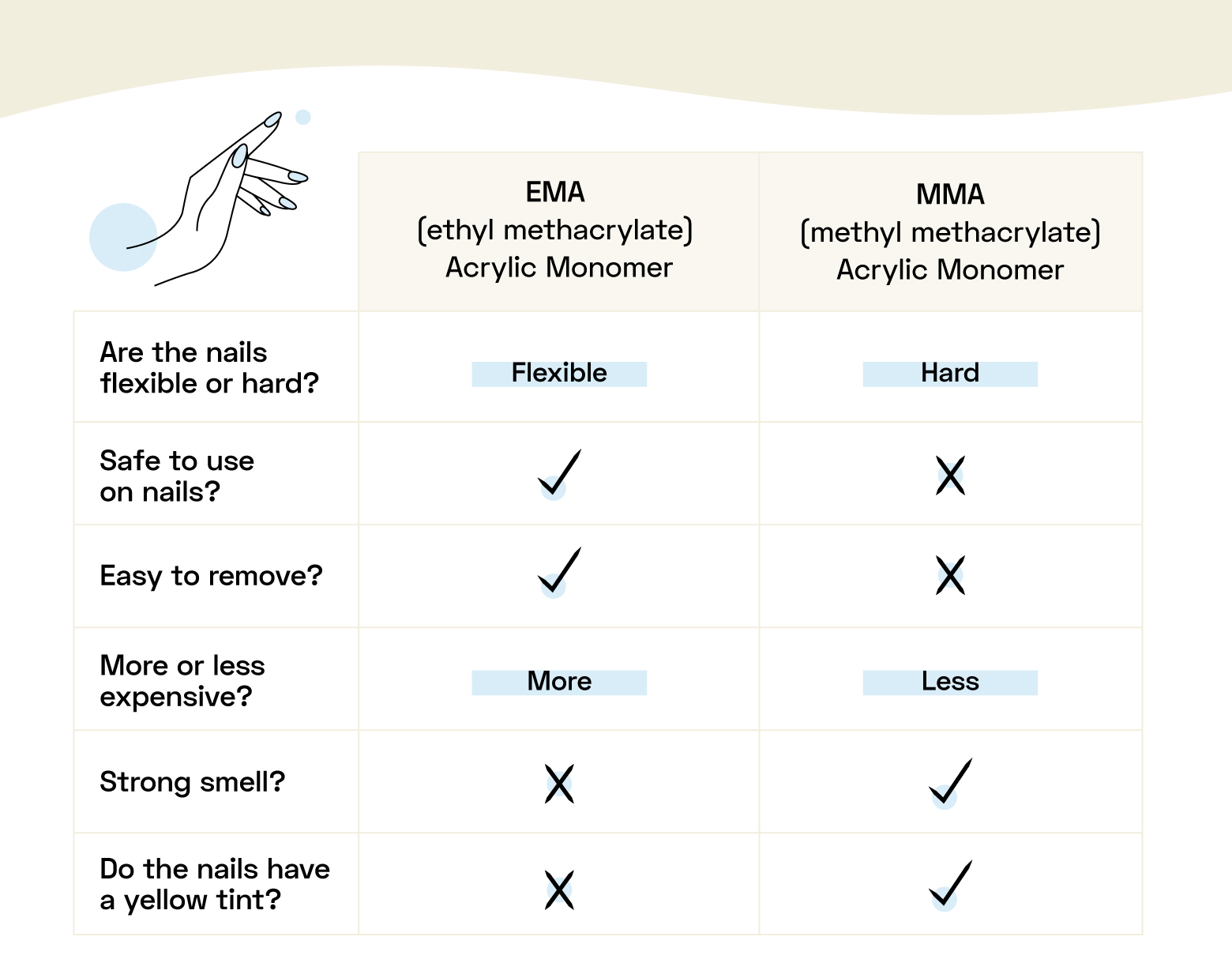
EMA
- Nails may be more flexible: Because EMA doesn’t make nails rigid as MMA does, you don’t risk losing your entire nail and nail plate when damaged. EMA results in a simple break instead of nail damage.
- Safe to use on nails: Unlike MMA, EMA is safe to use on nails.
- Easy to remove: The removal process for EMA is much easier than for MMA. Nails made with MMA usually can’t even soak off.
- Slightly more expensive than acrylics that use MMA: EMA is less toxic than this monomer, so it has a higher price tag. Because of this, nail salons may charge $10 to $15 more on SolarNails than other acrylic manicures.
MMA
- Nails may be very hard. Acrylic nails that use MMA are extremely hard. MMA is used as a monomer in dentistry, but SolarNails use EMA, making them pliable and easy to remove.
- MMA damages nails and fingers. MMA can lead to fingernail deformity and contact dermatitis.
- Nails may develop a yellow tint. MMA tends to give fingernails a yellow hue.
- Nails are difficult to remove. MMA creates such a strong bond to the natural nail that removal can require drills and long acetone soaks. SolarNails and other EMA acrylics are easy to remove with a simple soak.
SolarNails vs. acrylic, dip powder, and gel
Today, you have increasing options for manicure styles. To clear up any confusion, you can check out the following sections that explain the differences between SolarNails, traditional acrylic nails, and artificial nails that use dip powder or gel.
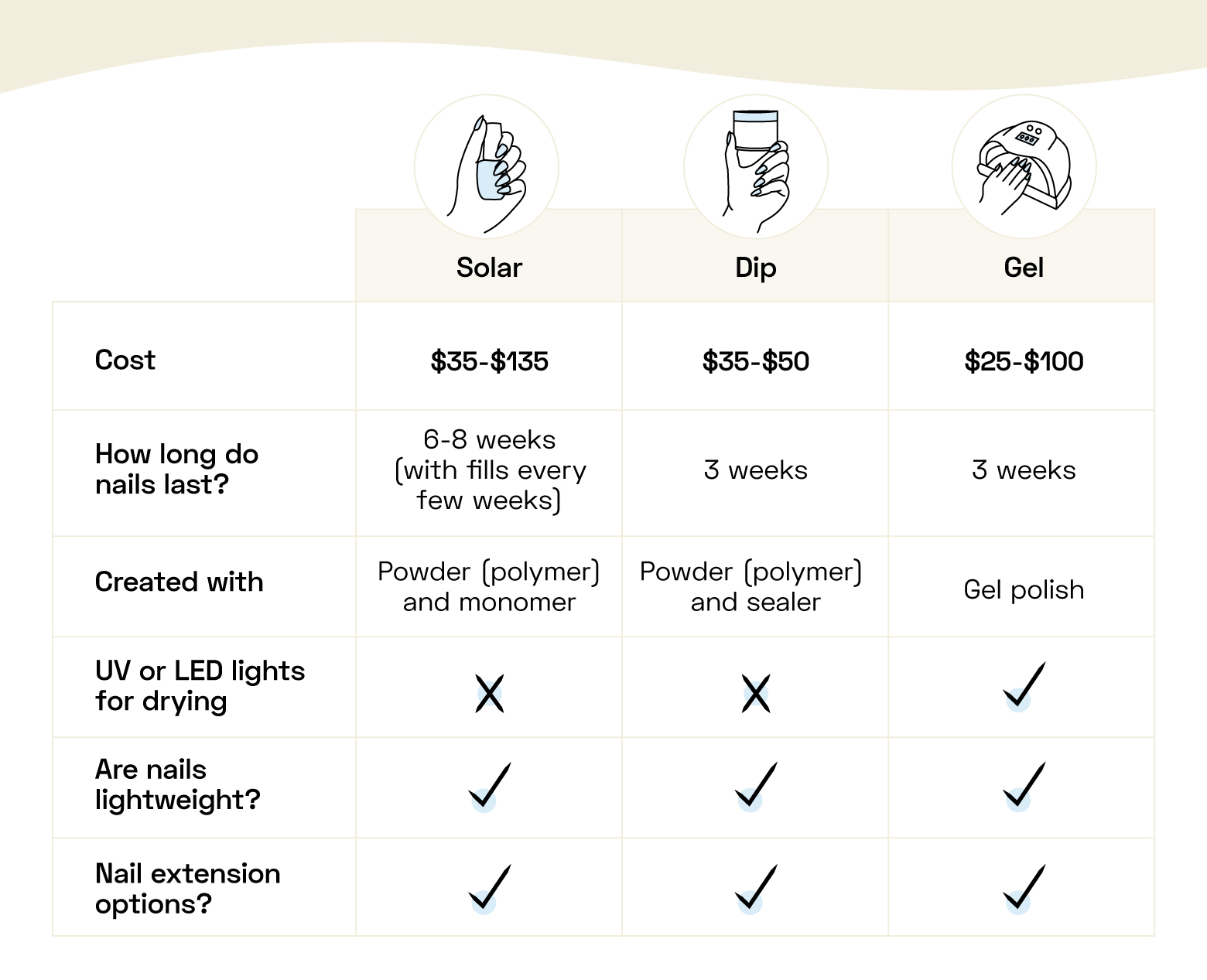
Dip powder nails
Although the process has been around for decades, the dip powder nail is trending. Since dip powder nails aren’t the same as SolarNails, including the application process, look, and feel, consider these differences before you decide on the nail service you want:
- Process: After a bonding nail polish is applied to natural nails, they are dipped in a colored powder. The topcoat dries and hardens the product after a few minutes without UV light.
- Durability: These long-lasting nails have greater flexibility resulting in less breakage than other nail types.
- Results: This type of artificial nail can last two to six weeks.
- Cost: A full set of dip powder nails costs $35 to $50.
Gel nails
People looking for nails that resist chipping for weeks often choose gel nail manicures. Nail technicians create gel nails by applying several coats of gel polish and curing them. Unlike acrylic nails, which are formed on the fingers, gel nails are the result of very strong nail polish.
- Drying: Nail professionals cure each layer of gel nail polish with a UV or LED light.
- Type: Gel nails are available as soft and hard. Soft gel nails are most frequently used. Nail technicians often use hard gel nails to lengthen nails and repair broken nails.
- Results: These artificial nails last about three weeks, but refills can extend their use.
- Cost: This type of manicure costs $25 to $100.
SolarNail application and removal process
CND’s formula for SolarNails doesn’t require much prep, equipment, or time. SolarNails don’t need to be cured, so you don’t sit under a UV light, and you don’t undergo a multistep process for their removal.
Application
The application process for SolarNails is a simple layering process. With this manicure, no chemical reactions are required to make them harden and hold.
- Prep the nails. Your natural nail plate is the foundation of the SolarNail, so preparing the area is the first step. The nails and cuticles are cleaned and trimmed and your nail beds are lightly filed.
- Apply nail tip. A nail professional attaches a translucent nail tip, trimming it to the desired length.
- Shape the nails. The nail tips are filed to the desired shape, and the ledge between the tip and nail bed is sanded down.
- Apply dehydrator and primer. The nail technician applies dehydrator followed by primer only to the natural nail bed.
- Use liquid EMA monomer and solar powder for the base coat. The nail tech dips a brush in monomer, brushes it once against the side of the container, then dips it into the powder. This mixture gets applied to the nail to form the acrylic, which hardens by air drying.
- Apply the top coat. The nail technician protects the SolarNails with a clear top coat, a gel nail polish color, shellac, regular nail polish, or the powder color that was used on the nail.
Removal
If you don’t have the time to visit your nail salon, removing SolarNails is so simple, you can do it at home. The manicure usually comes off without any buffing or filing.
- Soak nails in acetone. After soaking cotton balls in acetone, wrap each one around a nail and cover with aluminum foil for 15 minutes.
- Remove the nails. After unwrapping the foil, gently scrape off the top layer with a cuticle pusher.
- Repeat the wrapping. Cover your nails with acetone-soaked cotton balls and cover with foil for another 15 minutes.
- Remove the remaining layer of SolarNail. Remove the foil and gently scrape off the SolarNail with a cuticle pusher until the nails are completely gone.
Choosing the right nails
If you want a durable, long-lasting manicure, SolarNails may be the right choice for you. These artificial nails dry in minutes, last for two months and come off in a half hour. Because of SolarNail’s popularity, some salons say they offer it but are giving clients low-quality acrylic nails using MMA. If you’re too timid to ask your nail technician to confirm that you are getting SolarNails, look for signs of knockoffs, such as:
- Strong, chemical odor
- Nail professionals wearing masks during services
- Unlabeled containers
- Excessive drilling
- Low prices
- Nails that are difficult to remove

